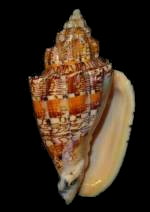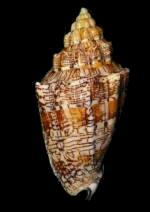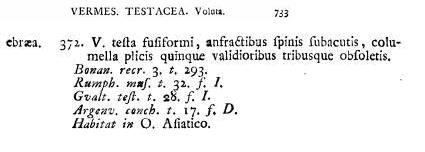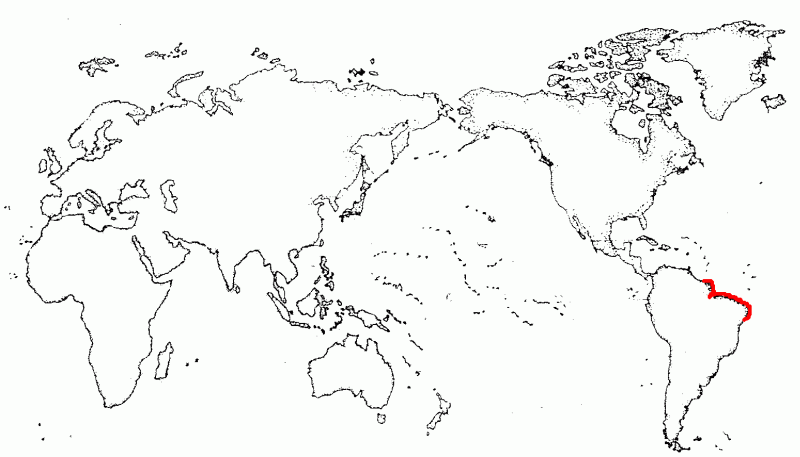
numero unico anno 2006
 |
page 064 |
page 066 |
 |
Voluta ebraea Linnaeus, 1758
Gilda Pianciamore
|
click on “next” button or on the images below to see specimen, varieties and forms
 
|
Sinonimi:
Synonyms
Voluta chlorosina Lamarck, 1811Voluta turbinata Kiener, 1839
Testo e descrizione originale di Linnaeus
Original text and description of Linnaeus

“Voluta testa fusiformi, anfractibus spinis subacutis, columella plicis quinque validioribus tribusque obsoletis” and "Habitat in Oceano Asiatico"
Linnaeus C., 1758. Systema naturæ per regna tria naturæ, secundum classes, ordines, genera, species, cum characteribus, differentiis, synonymis, locis. Tomus I. Editio decima, reformata.
DescrizioneSpecie di dimensioni medio-grandi, struttura spessa e robusta, forma globosoelongata. La spira, conica, è relativamente breve e occupa poco più di un quarto dell’altezza complessiva. Apice subacuminato, sutura incisa. Giri convessi che danno al profilo della spira un aspetto ondulato. Grossolane costulazioni assiali percorrono i giri della spira. Nella parte superiore del penultimo giro le coste evidenziano tubercoli appuntiti; mentre sulla spalla dell’ultimo giro questi diventano evidenti e corte spine. Lo stoma fusiforme occupa quasi l’intera altezza dell’ultimo giro. La callosità columellare mostra cinque pliche oblique molto evidenti mentre le successive tendono ad attenuarsi fino scomparire. La colorazione di fondo è giallo-crema. Ciascun giro inizia con una fila spirale di lineette assiali di colo bruno-rossiccio mentre sulla parte successiva dei giri le linee, dirette in senso spirale, circondano ad anello la conchiglia. Sull’ultimo giro le linee compongono due fasce spirali rosso-brune con macchie e variegature giallo-crema. Il resto della superficie mostra linee spirali irregolari spesso zigzaganti. Stoma e callosità columellare di color giallo-crema.DistribuzioneBrazil: Para, Maranhao, Ceara, Rio Grande do Norte, Paraiba, Pernambuco, Alagoas, Bahia. Nel Brasile è endemica delle coste più a nord ma non si rinviene nel nordovest del delta del fiume Amazon. Questo fattore è dovuto alla incapacità evolutiva della specie di attraversare la barriera di acqua dolce prodotta dal fiume. |
DescriptionSpecies of a medium-large dimension, of thick and robust structure, elongated-globe form. The conical spire is relatively short and takes up more than a quarter of the total height. Apex sub-pointed, incised suture. Convex turns/swirls give the spire profile a wavy look. Coarse axial ribbing runs along the swirls of the spire. In the upper part of the penultimate turn, the ribs throw out pointed tubercles, while on the shoulder slope of the last turn, these change to evident short spikes. The spindle-form stoma occupy almost the entire height of the last turn. The columellar callosity shows five very evident oblique envelopes/folds while those successive, tend to decrease, finally to disappear. The basic background colour is yellow-cream. Some of the turns begin with a spiral thread of axial hyphens - reddish-brown in colour, while on the successive part of the turns, the lines are directed spirally and circle and ring the shell. On the last turn, the lines are composed of two bundled groups of reddish-brown spirals with markings and cream-yellow variegations. The rest of the surface has irregular spiral lines that are quite often zig-zag. The stoma and columellar callosity are cream-yellow in colourDistributionBrazil: Para, Maranhao, Ceara, Rio Grande do Norte, Paraiba, Pernambuco, Alagoas, Bahia. In Brazil this is endemic of the coast more North but not found North-West of the Amazon Delta. This factor is due to the evolutionary incapacity of the species to cross the fresh water barrier produced by the river itself. |

Misure e profondità
Si rinviene da 0 a -40 mt
Raggiunge misure di circa 240 mm
Measurement and Depth
They are found from 0 to -40 mt.
Reach measurements of around 240 mm.
Testi di riferimento
Reference Texts
- Kiener, L. C. 1839. Genre Volute. (Voluta, Lam.) Spécies Général et Iconographie des Coquilles Vivantes 3 70 pp., 52 pls.
- Lamarck, [J. B.] 1811. Suite de la détermination des espèces de Mollusques Testacés. Volute. (Voluta.) Annales du Muséum
d'Histoire Naturelle 17 54-80.
- Linné, C. 1758. Systema Naturae, 10th ed., vol. 1 824 pp. Laurentii Salvii: Holmiae [Stockholm, Sweden].
- Oberling J.J. 1978 Color Patterns on Moluscan Shells: an Interpretation- Vol. 7
- Poppe G.T. and GOTO Y. 1992 Volutes - Informatore Piceno
- Rios E. de C. 1990 Gastropodes endemicos do Brazil - Siratus n. 4 year 1 may
- Weaver C.S. & duPont J.E. 1970 - Living Volutes
Notizie e curiositàLa pigmentazione di Voluta ebrea, insieme ad altre specie, è stata oggetto di un interessante lavoro sulla COMPLESSITA’ dell’organizzazione della natura e dei suoi viventi (Max Planck Institute). Lo studio si basa sul “Cellular Automata di Ingo Kusch e Mario Markus [1996]” derivato anche dal lavoro “Stationary Turing patterns and spiral waves” di Schepers e Markus [1992]. Simulando con il modello matematico Cellular Automata il comportamento delle singole cellule addette alla pigmentazione della conchiglia di un mollusco si suppone (interpretazione semplificata dell’autore) che esse si possano trovare in stato di disattivazione (nessuna pigmentazione) o attivazione (pigmentazione) in base alla presenza di appositi inibitori chimici. Dalla intermittenza di queste attivazioni/disattivazioni scaturisce il disegno della superficie della conchiglia. Quella che segue è una foto della pigmentazione di Voluta ebrea con a fianco il risultato del modello Cellular Automata. |
News and Curiosities
The pigmentation of the Voluta ebrea, together with other species, has been the object of interesting work done on the COMPLEXITY of Nature's organization and her living creatures. (Max Plank Institute). The study is based on the “Cellular Automata” (Autonomous Cells) by Ingo Kusch and Mario Markus [1996]”, and derived also from the work of “Stationary Turing patterns and spiral waves” by Schepers and Markus [1992]. By simulating the behaviour of the single cells actively employed in the pigmentation of the mollusc shell by means of the “Cellular Autonomata” mathematical model Cellular Autonomata, it is supposed - a simplified interpretation by the author- that these could find be found in a state of of dis-activation (no pigmentation) on the basis of the presence of the proper chemical inhibitors. From the intermittence of this activation/dis-activation, the design of the shell surface is set off. Here below is a photograph of the pigmentation of the Voluta ebrea and next to it, the result of the Cellular Automata model.
|

Note
Tutti gli esemplari selezionati appartengono alla Collezione A.M.I.
All the examples selected belong to the A.M.I Collection.
